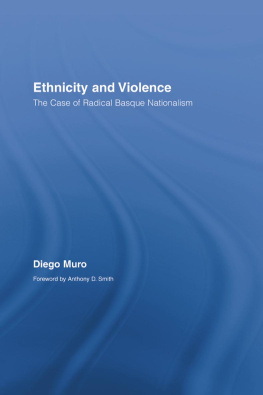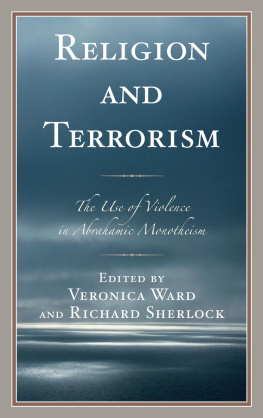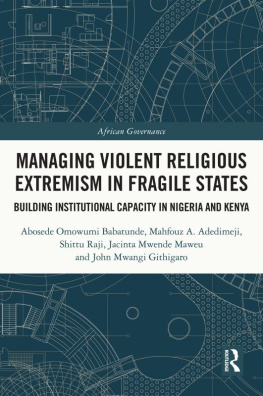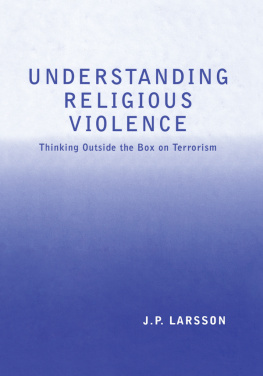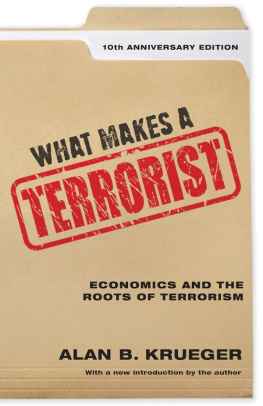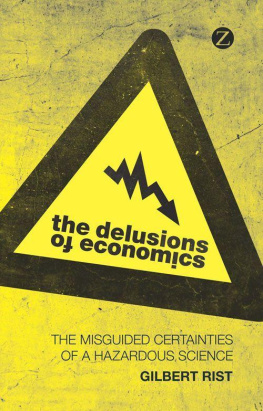Eli Berman - Radical, Religious, and Violent The New Economics of Terrorism
Here you can read online Eli Berman - Radical, Religious, and Violent The New Economics of Terrorism full text of the book (entire story) in english for free. Download pdf and epub, get meaning, cover and reviews about this ebook. City: Cambridge, year: 2011, publisher: The MIT Press, genre: Politics. Description of the work, (preface) as well as reviews are available. Best literature library LitArk.com created for fans of good reading and offers a wide selection of genres:
Romance novel
Science fiction
Adventure
Detective
Science
History
Home and family
Prose
Art
Politics
Computer
Non-fiction
Religion
Business
Children
Humor
Choose a favorite category and find really read worthwhile books. Enjoy immersion in the world of imagination, feel the emotions of the characters or learn something new for yourself, make an fascinating discovery.
- Book:Radical, Religious, and Violent The New Economics of Terrorism
- Author:
- Publisher:The MIT Press
- Genre:
- Year:2011
- City:Cambridge
- Rating:5 / 5
- Favourites:Add to favourites
- Your mark:
- 100
- 1
- 2
- 3
- 4
- 5
Radical, Religious, and Violent The New Economics of Terrorism: summary, description and annotation
We offer to read an annotation, description, summary or preface (depends on what the author of the book "Radical, Religious, and Violent The New Economics of Terrorism" wrote himself). If you haven't found the necessary information about the book — write in the comments, we will try to find it.
Eli Berman: author's other books
Who wrote Radical, Religious, and Violent The New Economics of Terrorism? Find out the surname, the name of the author of the book and a list of all author's works by series.
Radical, Religious, and Violent The New Economics of Terrorism — read online for free the complete book (whole text) full work
Below is the text of the book, divided by pages. System saving the place of the last page read, allows you to conveniently read the book "Radical, Religious, and Violent The New Economics of Terrorism" online for free, without having to search again every time where you left off. Put a bookmark, and you can go to the page where you finished reading at any time.
Font size:
Interval:
Bookmark:
Radical, Religious, and Violent
The New Economics of Terrorism
Eli Berman
The MIT Press
Cambridge, Massachusetts
London, England
2009 Massachusetts Institute of Technology
All rights reserved. No part of this book may be reproduced in any form by any electronic or mechanical means (including photocopying, recording, or information storage and retrieval) without permission in writing from the publisher.
For information about special quantity discounts, please e-mail
This book was set in Sabon by SNP Best-set Typesetter Ltd., Hong Kong. Printed and bound in the United States of America.
Library of Congress Cataloging-in-Publication Data
Berman, Eli.
Radical, religious, and violent : the new economics of terrorism / Eli Berman.
p. cm.
Includes bibliographical references and index.
ISBN 978-0-262-02640-6 (hbk. : alk. paper)
1. TerrorismEconomic aspects. 2. TerrorismReligious aspects. I. Title.
HV6431.B478 2009
363.325dc22
2009014105
10 9 8 7 6 5 4 3 2 1
Acknowledgments
Note to Readers
1 Why Are Religious Terrorists So Lethal?
Hezbollah
The Taliban
Hamas
The Lethality of Religious Radicals
What Motivates Terrorists? The Afterlife and Other Myths
Terrorist OrganizationsWhy So Few?
Internal Economies and Organizational Efficiency
Whats Coming?
2 The Defection Constraint
Origins of the Taliban
Trade Routes and Defection
Coordinated Assault
Terrorism and DefectionHamas
The Jewish UndergroundTerrorists Who Overreached
Hezbollah and Suicide Attacks
The Mahdi Army in Iraq
3 Sects, Prohibitions, and Mutual Aid: The Organizational Secrets of Religious Radicals
Prohibitions and Sacrificesthe Benign Puzzles
Where Are the Dads?
Mutual Aid
Prohibitions and Clubs
Fertility
Pronatalist Prohibitions
Radical Islam and Fertility
4 Sect, Subsidy, and Sacrifice
Subsidized Sacrifice
Madrassas
Subsidized Prohibitions and Fertility
How Many Radical Islamists?
Recap
5 The Hamas Model: Why Religious Radicals Are Such Effective Terrorists
The Hamas Model
Origins of the Model
Hamas
Social Service Provision by the Taliban, Hezbollah, and al-Sadr
Why Religious Radicals Are Such Lethal Terrorists
Terrorist Clubs
Evidence
When Terrorists Fail
Clubs and Violence without Religion
Gratuitous Cruelty
Objections
6 Why Suicide Attacks?
Rebels, Insurgents, and Terrorists
Suicide Attacks
Evidence
Coreligionists Are Soft Targets
Clubs
Alternative Explanations
The Future of Suicide Attacks?
7 Constructive Counterterrorism
How Terrorist Clubs Succeed
Constructive Counterterrorism
Whats Wrong with the Old-Fashioned Methods?
Where to Start?
The Malayan Precedent
8 Religious Radicals and Violence in the Modern World
Radical Christians, Benign and Violent
The Supernatural and Credibility
Markets and Denominations
Jewish and Muslim Denominations
Whats Wrong with Religion in Government? Competition and Pluralism
Not about Us
Whats Our Role?
Analytical Appendix
The Defection Constraint
Clubs, Loyalty, and Outside Options
Suicide Attacks vs. Hard Targets
Protecting Hard Targets by Improving Outside Options
Notes
References
Index
If you tell almost anyone that you study religion and terrorism, they typically have a few thoughts to share. I am grateful for most of those insights, but feel particularly obliged to the following people.
The soldiers and officers of the Golani Brigade taught me counterinsurgency many years ago. They are some of the most talented and impressive colleagues Ive ever worked with. Its a tribute to their training, bravery, and professionalismand to good luckthat I returned home unscathed; many of my comrades did not return at all.
When Ruth Klinov and I first started puzzling over ultra-Orthodox economics we received critical guidance from Menachem Friedman of Bar Ilan University, the worlds expert on the Israeli ultra-Orthodox community. Since then Ive drawn many times from his deep well of knowledge. Friedman has also let me accompany him as he conducted fieldwork and interviews in ultra-Orthodox neighborhoods of Jerusalem.
Several research assistants have cleverly managed data and contributed original ideas to this project over the years, including Liang Choon Wang, Lindsay Heger and Tiffany Chou of UC San Diego, who deserve special thanks.
My friend Susan Shirk and my agent, Jill Marsal, enthusiastically encouraged me to write a book accessible to a broad audience, even when I was just as happy to follow the safer path of writing academic articles. My editor, John Covell, and the staff of the MIT Press are responsible for keeping this project moving when I strayed from the chosen path. They also enforced high standards of production and guided the manuscript in the direction of accessibility. Any remaining obscure academic formulations are the result of my own stubbornness, not of any failure on their part.
David Bermanwho managed to complete an excellent book on ethical graphic design in the time it took me to revise a drafthas been a generous sibling rival, improving and accelerating my work.
Andrea Hill of the UC Institute on Global Conflict and Cooperation, and Lindsay Heger of the UC San Diego Political Science Department, read patiently through the manuscript more times than I care to mention. They provided fresh pointers each time. Shier Berman provided critical insights on the writing of the first draft.
My colleagues at Boston University, Rice University, UC San Diego, and at the National Bureau of Economic Research have supported my forays into territory not usually considered economics with cheerful and constructive advice. Ive been fortunate to be surrounded by unusually clever and creative social scientists, but Im especially indebted to Kevin Lang and Roger Gordon, who have been generous mentors.
This book would not have been written (at least by me) were it not for the influence of two daring scholars who unfortunately are no longer with us. Yoram Ben-Porath of the Hebrew University, who taught me introductory economics and later mentored me, demonstrated to his students the broad landscape that economists can aspire to explore. The late Zvi Griliches, one of my dissertation advisors at Harvard, greeted my initial decision to study the economics of ultra-Orthodox Jews with his usual excited curiosity and perceptive questions; at our next meeting he produced a pile of relevant and excellent books from his own library, both fiction and nonfiction. I like to think that Ben-Porath and Griliches would have enjoyed reading this work.
My coauthors have selflessly shared their intellectual contributions, which pervade this book. Ive tried in the text to note the major contributions of Laurence Iannaccone, Ruth Klinov, David Laitin, and Ara Stepanyan. Id like to acknowledge that the aggregate mass of their minor contributions is also critical.
Any mistakes of omission or commission are of course my own.
My parents, Shirley and Shier Berman, have supported all my adventures, however far they have taken me from home.
There is only so much time. My remarkable wife Linda Oz and our two terrific children have been generous and patient with their affection as Ive taken time that was rightfully theirs to write this book. Im especially grateful to them for letting me work quietly, even when Ive secluded myself to write on weekends and family vacations.
Next pageFont size:
Interval:
Bookmark:
Similar books «Radical, Religious, and Violent The New Economics of Terrorism»
Look at similar books to Radical, Religious, and Violent The New Economics of Terrorism. We have selected literature similar in name and meaning in the hope of providing readers with more options to find new, interesting, not yet read works.
Discussion, reviews of the book Radical, Religious, and Violent The New Economics of Terrorism and just readers' own opinions. Leave your comments, write what you think about the work, its meaning or the main characters. Specify what exactly you liked and what you didn't like, and why you think so.



